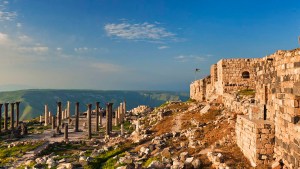Lenten Campaign 2025
This content is free of charge, as are all our articles.
Support us with a donation that is tax-deductible and enable us to continue to reach millions of readers.
On the southeastern shores of the Dead Sea, almost hidden within the dramatic Jordanian landscape, lies the Sanctuary of Agios Lot — a site deeply steeped in biblical history. Not too far away from the modern town of Safi (known as Zoara in ancient times), this sanctuary offers pilgrims and travelers alike a rare glimpse into a space deemed sacred – one that has touched the hearts of believers belonging to different monotheistic traditions for millennia.
The Sanctuary of Agios Lot, also known as Deir ‘Ain ‘Abata, holds special significance in both scripture and archaeology. It is depicted on the famed 6th-century Madaba Mosaic Map of Jordan as the “Sanctuary of St. Lot.” The fact that one finds the place already included in this legendary map underscores its importance during the Byzantine era as a favored Christian pilgrimage site.
The focal point of the sanctuary is Lot’s Cave, a modest yet hallowed space believed to be the refuge where Lot and his daughters sought shelter after the destruction of Sodom – a biblical episode told in Genesis 19.
Stepping into Lot’s Cave, though it is humble in size, evokes a sense of reverence. This now unassuming room once boasted marble floors and has yielded archaeological treasures, pointing to centuries of religious tradition. Excavations show that the cave remained a spiritual hub into the early Abbasid period, revered by both Christians and Muslims, as Lot is also honored as a prophet in Islam.
Lot’s monastery
The remains of a wider monastic complex, once an example of local Byzantine architecture, encircle this sacred cave. The basilica’s mosaics, dating from the 7th century, alongside Greek inscriptions mentioning Lot, bear witness to the ancient Christian veneration of the site. The discovery of living quarters, a pilgrims’ hostel, and even an ancient cistern-turned-burial chamber paints a vivid picture of what monastic life once was in the region.

Today, this ancient sanctuary, carefully preserved by the Jordan Tourism Board, invites travelers seeking to reconnect with the sacred past. In a land shared by Jews, Christians, and Muslims, visitors encounter an unbroken thread of worship that links past and present – a sanctuary carved into the earth yet reaching toward the heavens.
For those with a heart for pilgrimage, the Sanctuary of Agios Lot offers not only a journey through history but a profound encounter with the shared spiritual heritage of the Holy Land.



